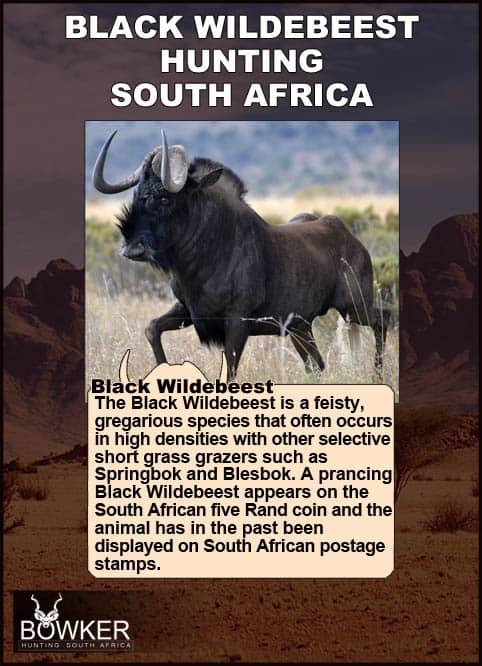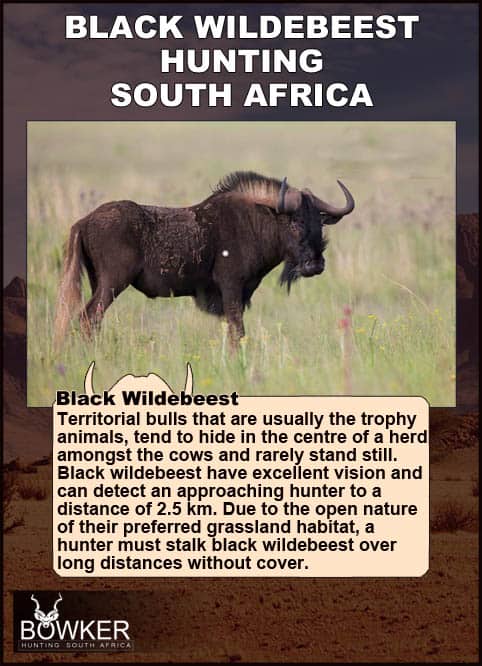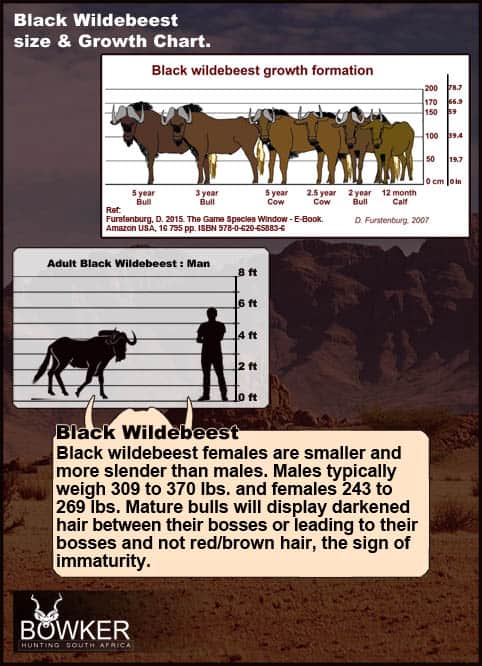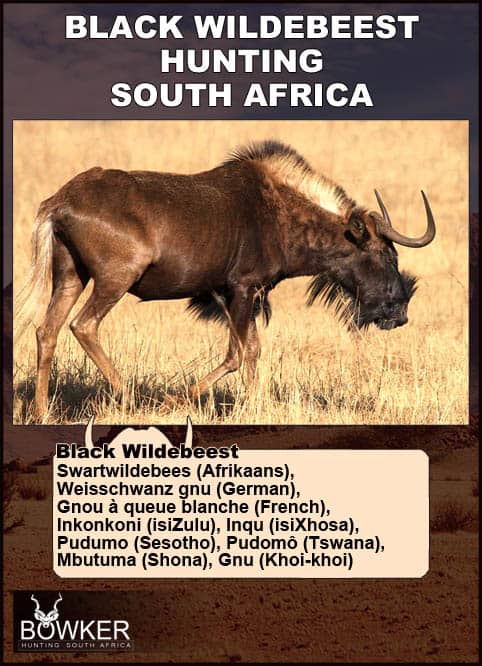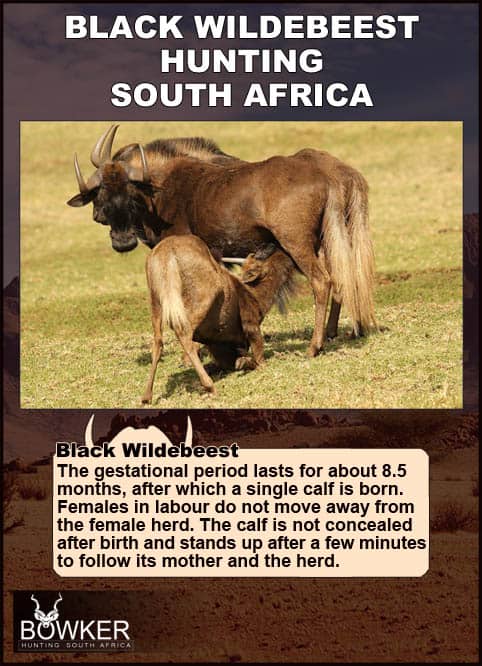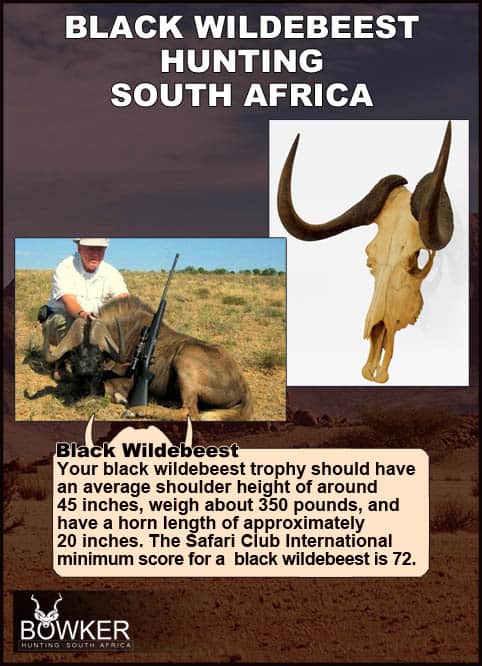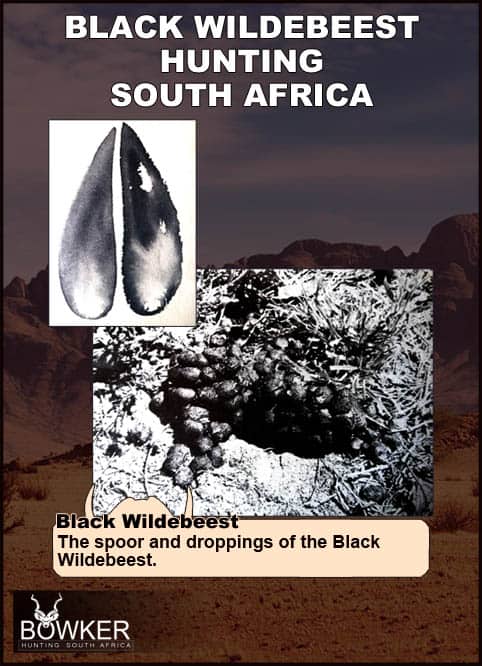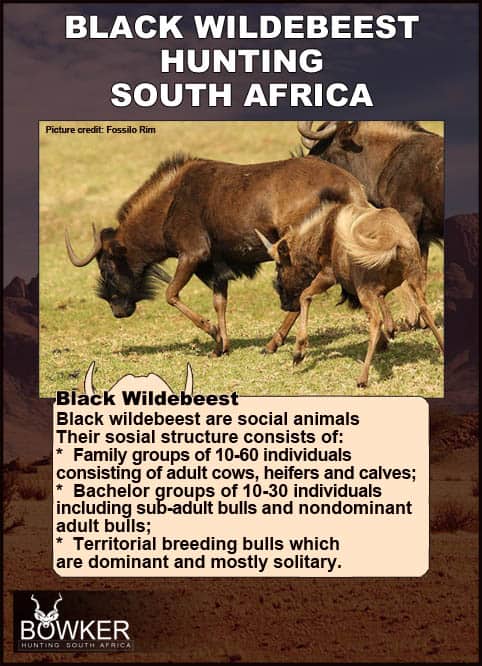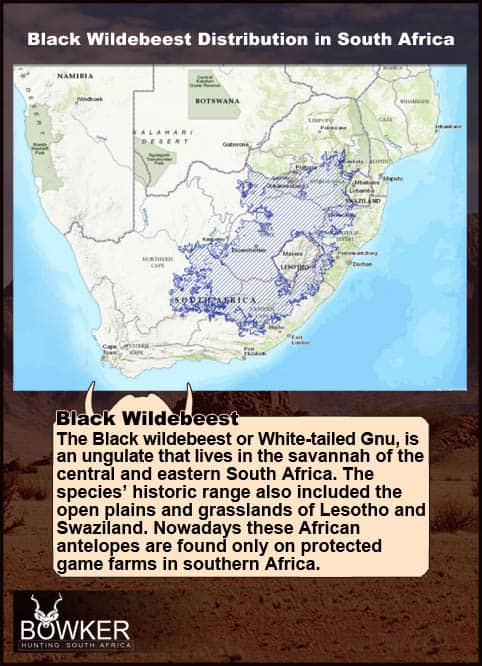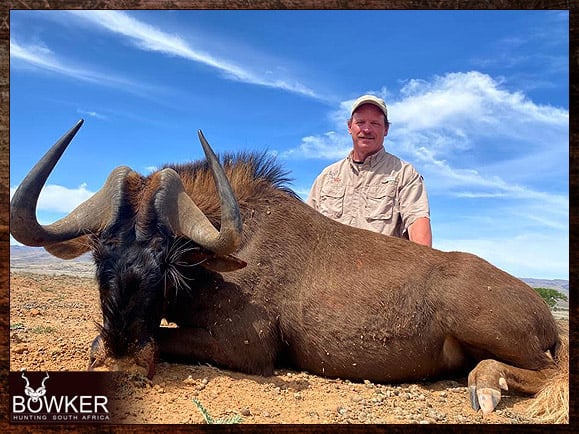
Summary
Black Wildebeest Trophy hunting in the Eastern Cape is widespread.
This animal was saved from extinction, with only 17 animals remaining in South Africa. Black Wildebeest is one very tough animal.
There are no seasonal restrictions on Black Wildebeest in Eastern Cape, South Africa.
Nick Bowker Hunting offers Black Wildebeest hunting in Africa year-round.
Hunt Black Wildebeest on the open plains of Africa.
We have a number of packages with Wildebeest hunts.
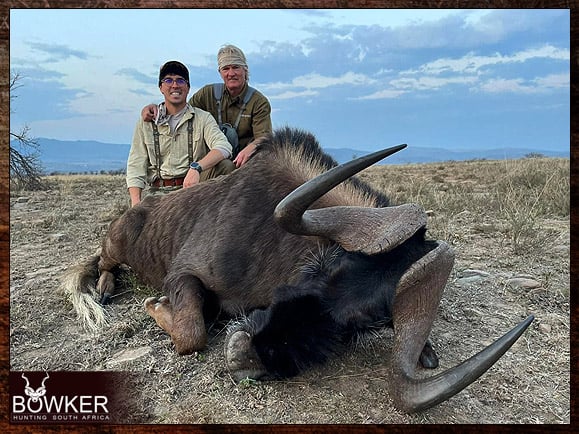
Table of Contents
Black Wildebeest Trophy Fees -2025
The average price of a Black Wildebeest is $900 – 1500. Cheap African hunting safari packages often include a Black Wildebeest Trophy.
Our 2025 price is $1200
All-Inclusive $5500 Starter Plains Game Package for seven trophies and eight days hunting. (Inclusive of a Black Wildebeest Trophy)
- Kudu
- Black Wildebeest
- Impala
- Springbok
- Blesbok
- Warthog
- Mountain Reedbuck
The Black Wildebeest trophy hunting package includes a licensed hunting guide and a hunting license, and all permits.
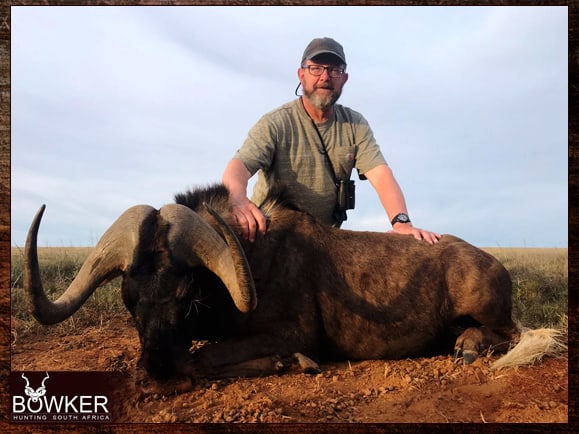
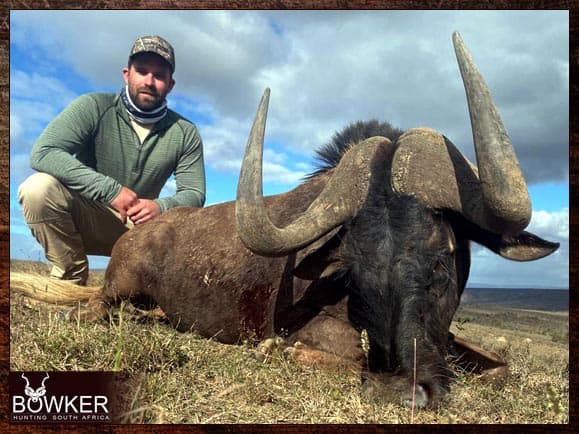
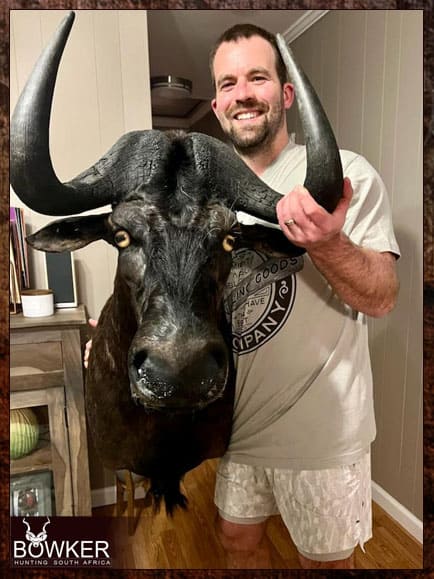
Black Wildebeest Hunting
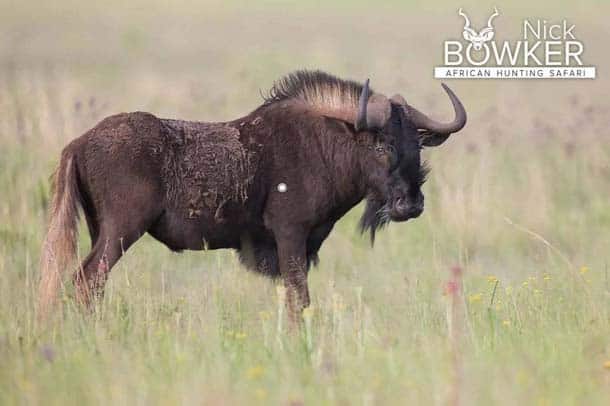
Shot placement must be in the bottom third of the animal directly above the front shoulder. This will ensure a heart or lung shot. Avoid head and neck shots, which are high-risk.
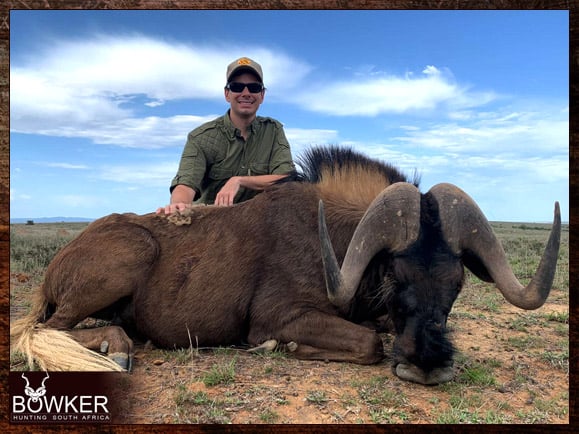
Your Black Wildebeest trophy should have an average shoulder height of around 45 inches, weigh about 350 pounds, and have a Horn Length of approximately 20 inches. The Safari Club International minimum score for a trophy black wildebeest is 72.
Trophies are measured by measuring the length along the outside of the horn curl from tip to tip, plus the straight-line width measurement of both bosses for a combined total score in inches.
Black Wildebeest are also known as the White-Tailed Gnu or the “Clowns of Africa” due mainly to how the way they run in circles when approached.
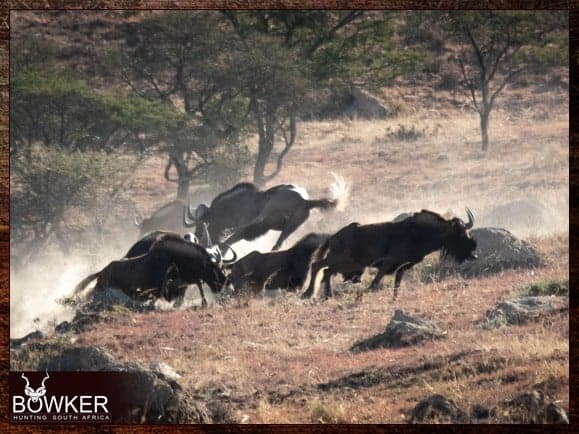
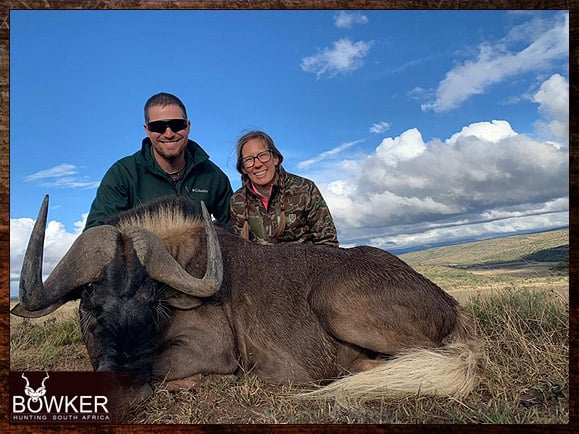
Nick Bowker has access to several black wildebeest herds for game hunting. Hunting blesbok and black wildebeest in Africa are very similar, with both species out on the open plains and savanna.
Anthills are the main hiding point as you try and ambush these plains animals.
As with blesbok, black wildebeest bunch together at stages, so careful communication with Nick Bowker, your professional hunter, is essential.
Black Wildebeest Trophy Hunting is conducted by setting up ambushes, looking down valleys, or spot and stalk.
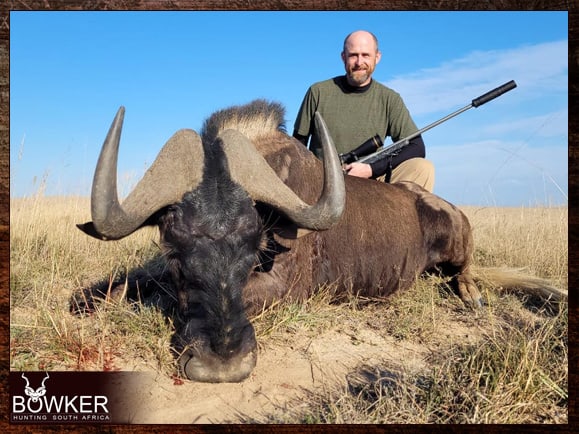
Trophy Judgement and Rifle Caliber for Hunting Black Wildebeest
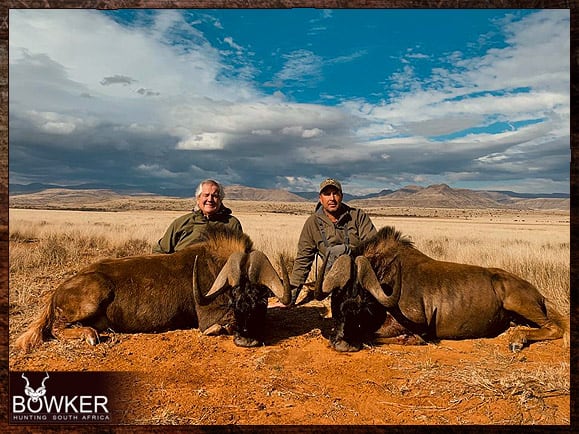
It can takes patience to distinguish the bulls from the cows, with both sexes carrying horns.
Hunt Wildebeest during the morning or late afternoon while the herd is grazing in the open. Choose a herd member carefully.
In cool weather, they graze anytime but tend to rest during the hottest part.
Black Wildebeest can be very aggressive when mating, disturbed or wounded. This ‘clown of Africa’ will often trot in circles and chase other herd members.
Big bulls are territorial and often return to their territory shortly after being disturbed by the hunter.
Judging Black Wildebeest trophy quality, it’s essential to look at the boss’s size and the curl’s drop. Also, consider the height and rise of the tips.
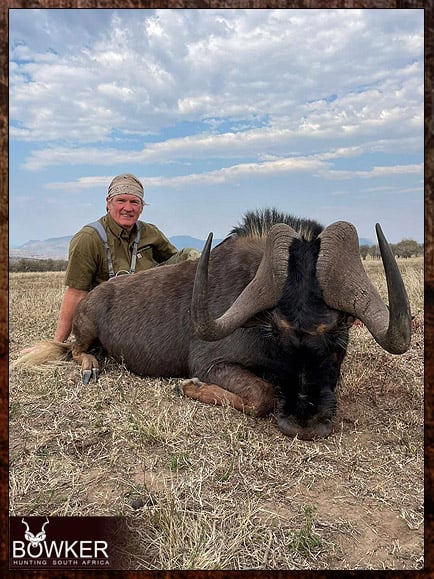
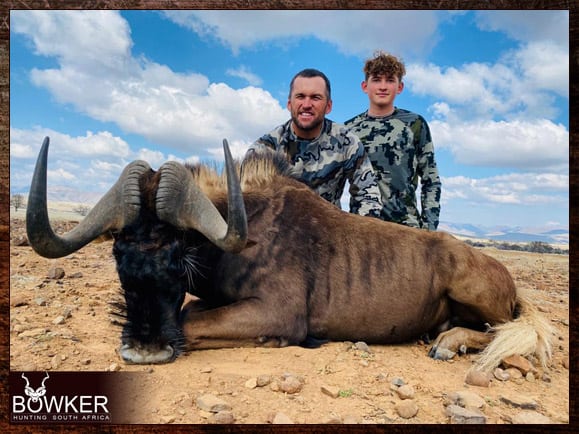
Mature Black Wildebeest bulls will display black hair on their faces and bosses. Red or brown hair is a sign of immaturity.
He’s a very tough game animal to bring down. Bow hunting Black Wildebeest is difficult in a free-range environment.
Black Wildebeest hunting in South Africa on open terrain calls for a flat shooting caliber. Therefore, we recommend the flat shooting magnums.
For those hunters who wish to avoid going through the red tape of bringing a rifle into South Africa, Nick Bowker Hunting has 300 Winchester Magnums fitted with suppressors.
Mounted on the rifles are Swarovski tactical scopes. We have hand-loaded Hornady ELD-X 200-grain ammunition. The rifle, including ammunition, is free of charge as part of all hunting packages.

Difference Between Male and Female for Wildebeest hunting
The horns have a broad base in mature males. The male is more prominent with heavier and slightly longer horns than the female and higher at the shoulder. A shield forms by flattened horns for protection; this is not the female’s case.
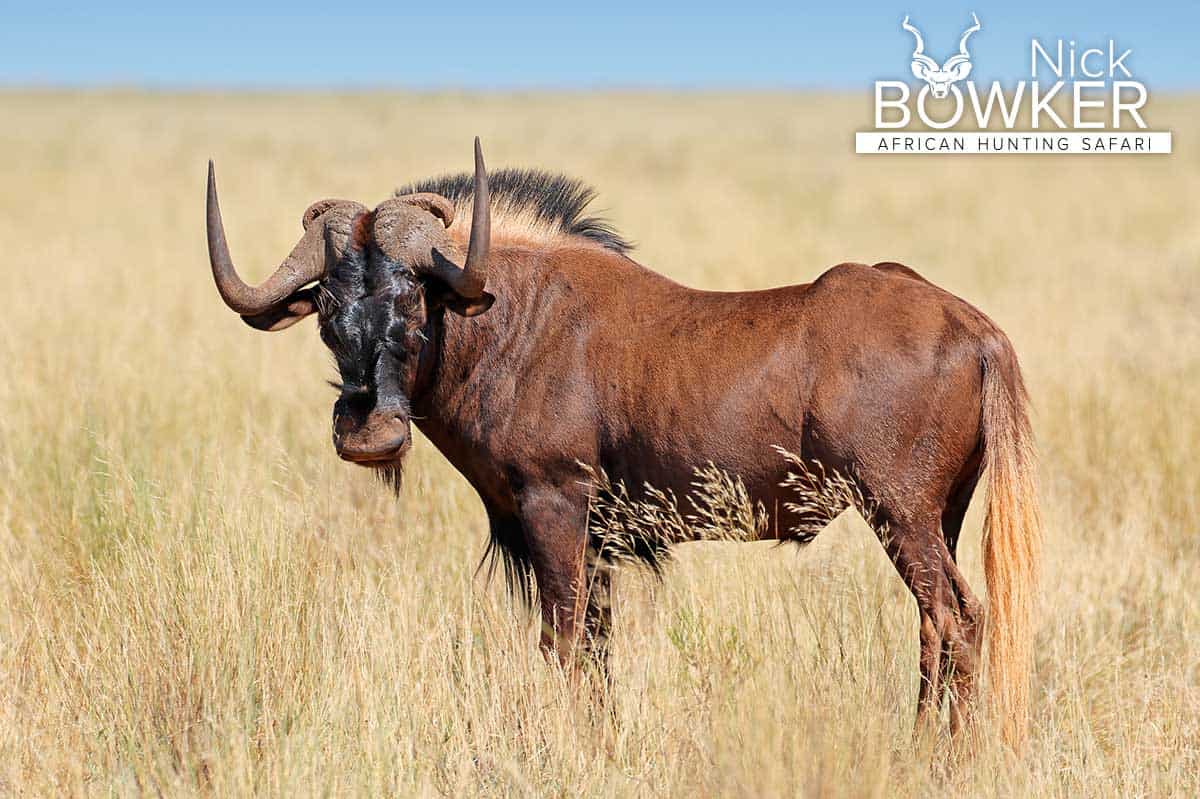
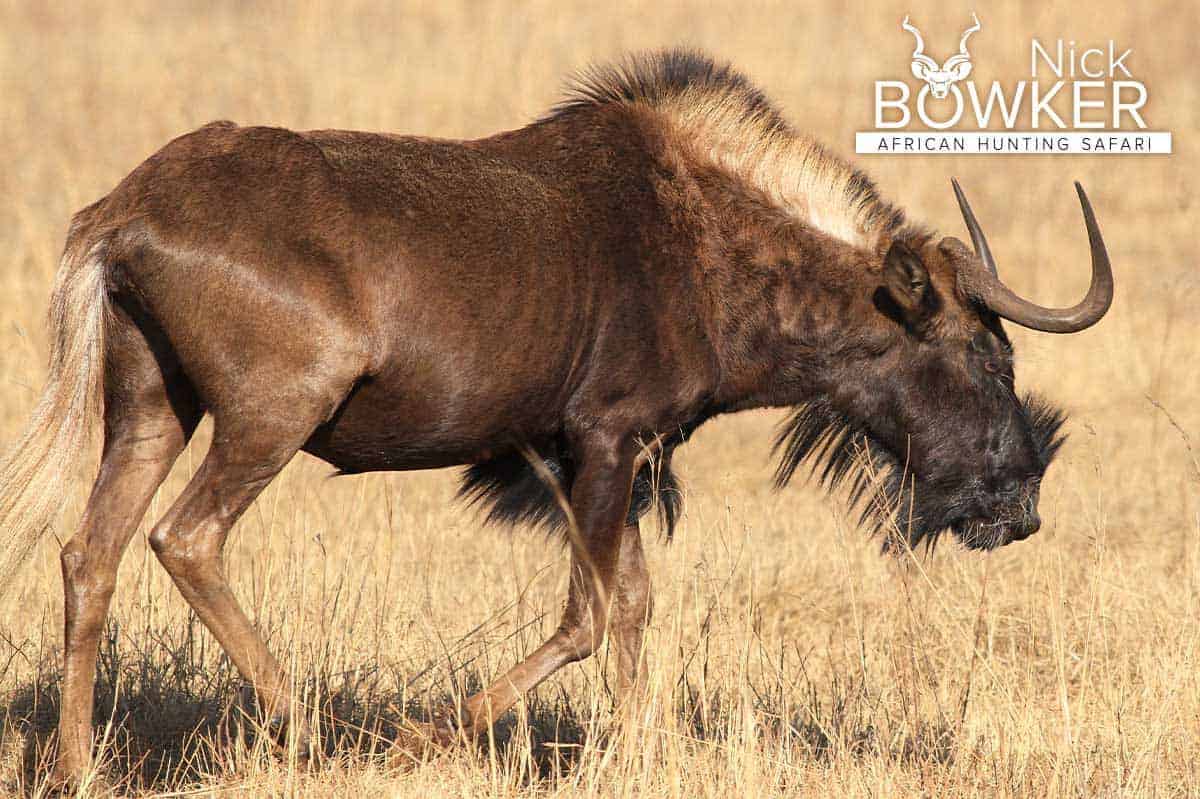
Wildebeest Hunt – Interesting Facts

- Also known as White-tailed gnu, the Black Wildebeest lives in the savannas and plains of South Africa.
- The species’ historic range also included the open plains and grasslands of Lesotho, Swaziland, and Free State.
- The most interesting fact about Black Wildebeest is their comeback from near extinction. Only 17 of these animals remained after being eradicated by Mucous Disease.
- Nowadays, these African antelopes are plentiful across South Africa.
- Black Wildebeest hunting is now commonplace on private reserves.
- Historically, Black Wildebeest inhabited the northern temperate grasslands during the dry winter and migrated to the arid southern regions during the rainy season.
- When their numbers were much higher naturally in the central plains of South Africa, they never migrated on masse as their close relative, the Blue Wildebeest, still does in places.
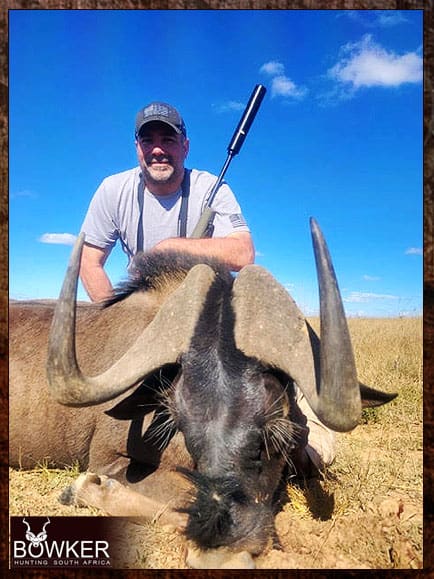

- Being very gregarious animals, forming groups consisting of males and females with calves is usually 30 to 500 individuals.
- It is also seen in groups composed solely of females and their offspring or by single males.
- In periods of drought, animals of various groups gather in herds, reaching thousands of individuals. These herds migrate towards the major rivers and lakes across considerable distances.
- Wildebeest is associated with other African animals. These include springbok, impala, and zebras. They may also associate with ostriches on the Southern African plains.
- The Black Wildebeest can run up to a speed of 50 mph. They serve as prey for large predators. Predators include lions, hyenas, leopards, cheetahs, and cape-hunting dogs.
- The lifespan of the black wildebeest is about 15 -20 years.
- Black Wildebeest requires excellent shot placement as they are incredibly tough and resilient.
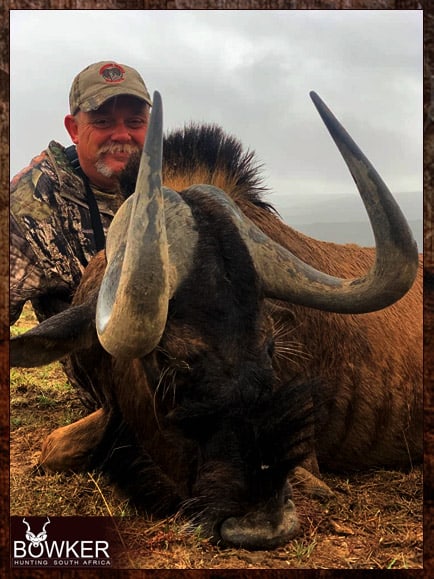
About the Black Wildebeest or Gnu
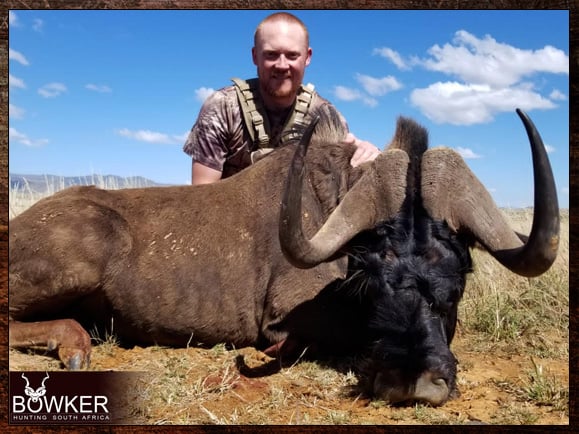
The Black Wildebeest inhabits open plains, grasslands, and Karoo shrublands in steep mountainous regions and lower undulating hills.
A dominant male Black Wildebeest has a harem of females and will not allow other males to mate with them.
They have a dark brown to almost black coat, slightly paler in summer and coarser and shaggier in the winter. Calves are born with shaggy, fawn-colored fur. Males are generally darker than females.
They have bushy manes, like the blue wildebeest that stick up from the back of the neck.
Black Wildebeest females are smaller in size and more slender than males. Males reach about 44 to 48 inches at the shoulder, while females reach 42 to 46 inches.
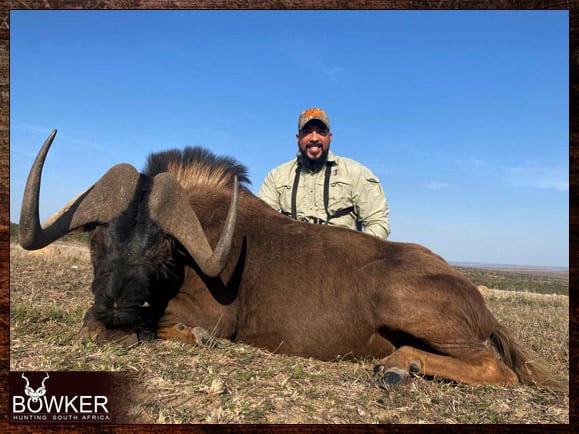
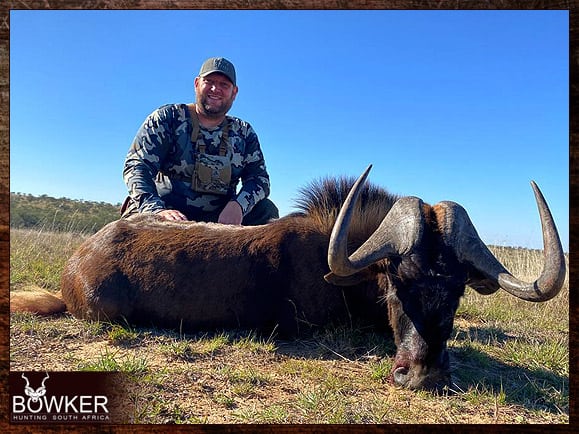
Males typically weigh 350 pounds, and females 250 pounds.
A distinguishing feature in both sexes is the bright-white tail, which is long and similar to a horse.
Its bright-white tail gives this animal the vernacular name of “white-tailed gnu” and makes it very easy to tell them apart from blue wildebeest, which has a black tail.
Both sexes have strong horns that curve forward, resembling hooks up to 24 inches long.
The horns have a broad base in mature males and are flattened to form a protective shield. In females, the horns are both shorter and narrower.
Wildebeest hunting is mainly on the open plains but also in savanna areas.
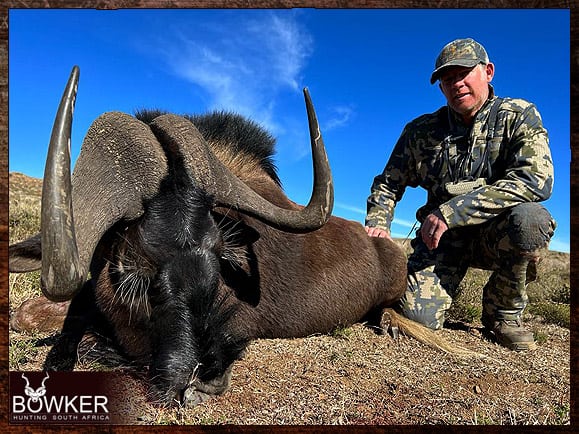
Frequently Asked Questions by the Hunter
How much does it cost to hunt a Black Wildebeest?
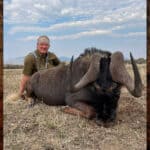
Trophy fees as a standalone Black Wildebeest hunt are between $800 to $1000. Daily rates vary between $250 to $500 a day.
Included in the Black Wildebeest trophy fee is a licensed guide. As well as a hunting license and all permits.
A Black Wildebeest trophy is often included in a Plains game package. Package prices vary from $ 3,000 to $10,000, depending on location and size. Packages include 5 – 7 trophy animals, accommodation, meals, and daily rates.
How to hunt Black Wildebeest?
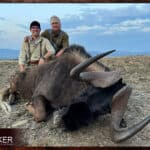
Black Wildebeest is hunted on the open plains. The Black Wildebeest is wary and difficult to approach. Longer shots will, therefore, be required.
Black Wildebeest bunch together. Shooting the right one will need careful communication with your professional hunter.
Where do you shoot a Black Wildebeest?

Shot placement must be in the bottom third of the animal directly above the front shoulder. This will ensure a heart or lung shot. Avoid head and neck shots, which are high-risk.
What is a trophy, Black Wildebeest?
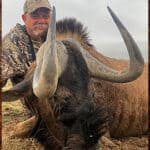
Black Wildebeest trophies have a Horn Length of approximately 19 – 21 inches. The minimum qualification score under Safari Club International for a Black Wildebeest is 72.
Trophies are measured by measuring the length along the outside of the horn curl from tip to tip, plus the straight-line width measurement of both bosses for a combined total score in inches.

Seasonal Restrictions
When can you hunt Black Wildebeest in South Africa?
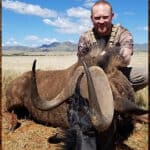
There are no seasonal restrictions on Black Wildebeest hunting in the Eastern Cape of South Africa for most outfitters.
How do you judge a Black Wildebeest trophy?
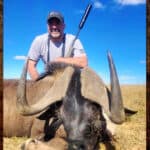
Judging Black Wildebeest trophy quality, it’s essential to look at the boss’s size and the curl’s drop. Also, consider the height of the rise of the tips.
Mature bulls will stand out in the herd and be more visible in horn length and shoulder height. The difficulty comes when approaching solitary bulls, where you must rely on your professional hunter.
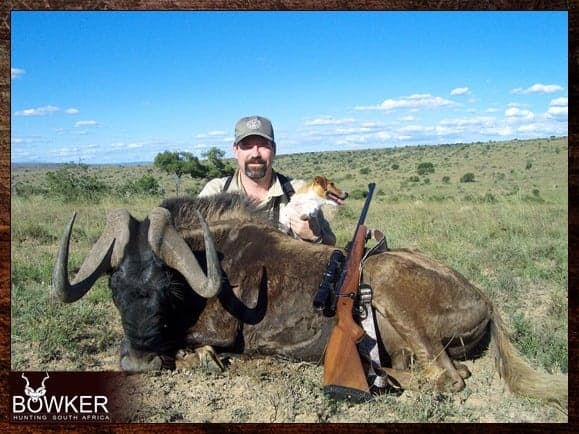
What Caliber is Recommended for Black Wildebeest hunts?
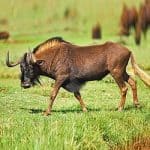
We recommend the flat shooting 300 Winchester or 7mm magnums with high-quality tactical scopes and a suppressor.
Black Wildebeest in Pictures
